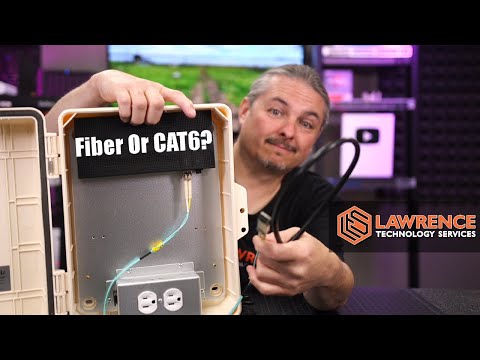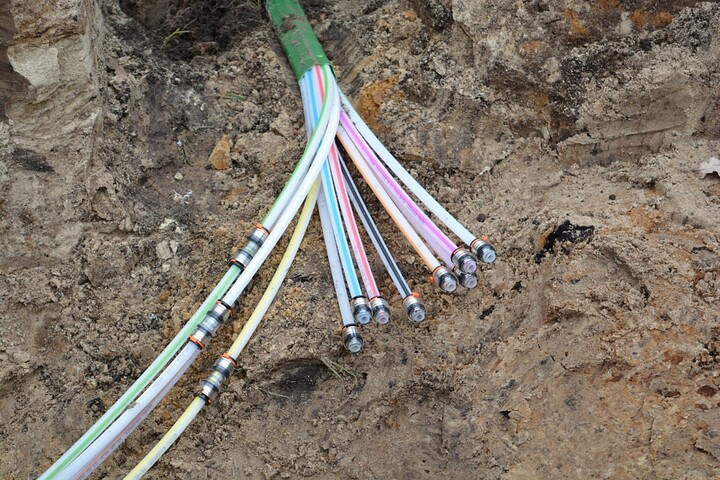I will have a run of 50ft indoors and then 200 ft outdoors. The outdoor cable must be direct burial. I thought at the end points of the 200ft cable to have some sort of ethernet repeaters. But then I thought just having switches would do the same thing. My question is what are the best things do do or buy to make sure the transmission is good
? Thanks
do you need CAT or can you run fiber? Generally for exterior and buried lines I prefer glass so that you dont need lightning protection on your network.
https://www.l-com.com/surge-protector-outdoor-10-100-1000-base-t-cat6-hi-power-lightning-protector-rj45-jacks
Now, outside if that requirement, 200ft is fine for CAT5/6 its rated for 100m or around 1000ft.
You should be fine without a repeater
When you lay outside the building, do it deeply and it is a good idea to make a proper grounding and even provide both sides with additional filters just in case.
As for CAT6 and long distances, maybe…
1Gb 656ft or 10Mb 850ft
Say it to the Ryan… ![]() Some time ago he said that his router port was damaged and he is hooked up to the ISP fiber optic cable.
Some time ago he said that his router port was damaged and he is hooked up to the ISP fiber optic cable. ![]()
Teretically optical fiber is much safer. But it is possible to send power through optical fiber… it has both power and distance limitations, but theoretically you can burn the port.
3 Fibers / 9M / 1W
I saw someone run XLR audio over an ethernet cable and phantom power carried over 1000FT of cable and worked. If you needed extra poomph that badly I think you could use something like a POE injector and buffer that signal a bit. I may be wrong on how POE works tho.
I like the idea of direct bury-ing fiber, because you can switch to 10Gbps / 25Gbps / 40Gb / 100Gbps without having to dig stuff up.
If you’re happy with 1Gbps there’s this thing: MikroTik Routers and Wireless - Products: GPeR
I’m surprised they don’t just use the steel reinforced core and a sheathing for the neutral return instead of a laser for the power. But hey you know what if it works, it works right?
Anyways to the OP, those distances are perfectly normal. You can do up to 330 ft at 10GBE or 1GBE speeds with cat6A as long as the cable is actually up to compliance
@paddle1 you do not need a repeater. If you’re only going to do gigabit speeds, which is what I’m presuming you care about, you don’t need a repeater and cables are cheap at that distance for CAT6. Everyone telling you to upgrade to fiber is telling you to get into it and expensive endeavor you may not need for the next decade
It’s a cool feature to be able to upgrade in place and not really need to run any new cables, but at the same time it’s not necessary and the money spent may not be necessary for your wants and needs anyways.
Regardless, if you’re whether you’re going to build fiber or not, you’re still going to need lightning arresting on both sets of cables even though they are buried because the truth of the matter is lightning can travel over both fiber and ethernet AKA plain copper. So there’s no cost saving nor advantage in this regard.
My advice is you tell everybody here what your actual needs are and what it’s being ran out to. Because if it’s not an essential server air conditioned in a shack outside your house then there’s really no need for all these other suggestions. Particularly if it’s just going to a wireless AP or just a computer sitting in a shed or a raspberry pi device, whatever it may be
Use case is important here and I think people can give you better advice if they know exactly what it’s going to and what it’s coming from
Whatever medium you choose to install (fiber or copper), when you run the line, run two. Very little extra expanse, but gives you a backup in case of issues and with the right gear can double your speed.
Also, consider point to point Wifi if you have direct LOS between the two endpoints. Some cheap building to building systems out there that can give you 1+ GB connectivity up to 500’. No digging required.
Glass is 10^14 Ohm per meter. So to get even 10mA after 1 meter, you need 10^12 Volt.
My physics formula booklet has lightning at 10^8 Volt. So unless the armour of the cable terminates directly into the switch, you are good.
Uhhh dude no
The buried cables have a metal core for rigidity if you use the proper burial grade cable
So while I agree with your physics class lesson and calculations, you don’t have the entire story. The issue it here is that steel core is actually enough to transmit lightning and there’s a lot of data out there and that’s why I’m advising that there is no difference here when you’re choosing these two types of cables, especially if you’re using burial grade on both
The thing here is that’s why we have lightning arresters on fiber cables in pretty much every industrial installation
At least around here, fibre is exclusively run through conduit, never direct burial. So no metal parts (except the connection-flanges on the “speed pipes”).
Image for reference:
Quick search yielded no results (apart from HV-lines, RF/Coax and RJ11/45), any manufacturer or part number to look up? I am very interested.
That’s because it’s not a special piece of equipment like it would be for ethernet. Most of the time it’s just built into the industrial equipment and fiber termination equipment itself at each end. These equipment include optical distribution frames (ODFs), fiber optic cabinets, fiber distribution boxes, fiber terminal boxes, etc. Their grounding solutions are nearly the same. They’ve already taken this into account because they don’t want the end user to do so. But that’s also what adds to the cost of these pieces of equipment. Hence, why a fiber installation always cost more and I took a look at your photo and while it’s in a conduit and thats great, that’s not where the grounding issues going to occur. In this case, I’m assuming you’re referring to fiber to the home. If you follow the multimode out to the multimode terminator next to a house you’ll find there’s a metal termination and connected to a grounded piece of metal, whether that be the case being grounded or the actual optical termination frame or OTF. Grounding is built in because from fibers inception: This was an understood need. Whereas for ethernet it wasn’t as it was mostly an indoor installation and the equipment itself was already surge protected. But now you can see that for an underground burial cable for ethernet this would be essential
Follow that multimode fiber out to the single mode fiber and you’ll find a very massive grounding point as well as a grounding wire if it’s an aerial termination on the pole (rare)
If we are talking about PoF, probably the greatest advantage of using it is the greatest possible insulation so as not to create a bridge between A-B.
Advantages of Power over Fiber
Although an insulated copper wire is a simpler technology for transferring electric power, power over fiber offers advantages in specific situations:
Non-conducting fiber cables (based on glass fibers or plastics) can be installed where high electric voltages occur. For example, a fiber can transmit power for a current transducer in a high-voltage transmission line. (Note that there are also fiber-optic sensors where no electrical power is needed locally.) Such current sensors with an optical power isolator can replace bulky transformer systems.
The insulating property is also useful when a device (e.g. some radio signal receiver) is connected to an antenna, which could be hit by lightnings. There is then no risk that lightning strokes are transmitted via the cable.
Optical delivery of power avoids any sensitivity to strong magnetic fields (e.g. in magnetic resonance imaging) and to electromagnetic interference. Conversely, no electromagnetic radiation, which might disturb other devices, can be emitted, and also no DC magnetic fields are generated.
There is no risk that explosive materials (e.g. in a fuel tank of an airplane) can be ignited, as could occur e.g. via an electric spark.
In a system for optical fiber communications, there may be spare fibers which can be used for transmitting power when an electrical connection does not exist. Other possibilities are to use some separate fiber core(s) of a multi-core fiber, or even to use one fiber core for both power delivery and data transmission.
A fiber can have a far lower weight than an electrical cable, and may also be thinner.`
The same fiber may be used to send back data e.g. from a sensor, using some other wavelength channel.
Therefore, a number of applications can be envisaged in areas such as industrial sensors, aerospace, and optical communications.
Obvious disadvantages are the cost of optical components and the limited potential in terms of available power and conversion efficiency. There may also be a laser safety issue associated with several watts of optical power, which can leave the fiber when it is broken.
So the thesis about damage to the router / WAN port at home if the installer did not properly connect the ground is possible?


